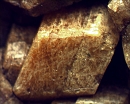
|
| Andesine |
Chemical
Formula |
(Ca,Na)(Al,Si)4O8, where Ca/(Ca + Na) is between 30%-50% |
Species |
Silicates |
Crystal
System |
Triclinic |
Mohs
Scale |
6 |
Specific
Gravity |
2.66-2.68 |
Color |
White, gray, green, yellow, flesh-red |
Streak |
White |
Luster |
Sub-Vitreous, Pearly |
Refractive
Index |
n = 1.543 - 1.554 n = 1.547 - 1.559 n = 1.552 - 1.562 |
Diaphaneity |
Transparent, Translucent |
Cleavage |
PerfectPerfect on , less perfect on ; also observed. |
Fracture |
Irregular/Uneven, Conchoidal |
| Crystal Habit:Crystals rare, to 2 cm; commonly massive or granular |
| Geological Setting:Widespread in igneous rocks of intermediate silica content, as syenites and andesites. Characteristic of granulite to amphibolite facies metamorphism, commonly as antiperthite; as detrital grains in sedimentary rocks. |
Andesine is a silicate mineral, a member of the plagioclase feldspar solid solution series. Its chemical formula is (Ca, Na)(Al, Si)
4O
8, where Ca/(Ca + Na) (% Anorthite) is between 30%-50%. The formula may be written as Na
0.7-0.5Ca
0.3-0.5Al
1.3-1.5Si
2.7-2.5O
8.
The plagioclase feldspars are a continuous solid solution series and as such the accurate identification of individual members requires detailed optical study, chemical analysis or density measurements. Refractive indices and specific gravity increase directly with calcium content.
Name and discovery
Andesine was first described in 1841 for an occurrence in the Marmato mine, Marmato, Cauca, Chocó Department, Colombia. The name is for the Andes due to its abundance in the andesite lavas in those mountains.
Occurrence
Andesine occurs in intermediate igneous rocks such as diorite, syenite and andesite. It characteristically occurs in metamorphic rocks of granulite to amphibolite facies commonly exhibiting antiperthite texture. It also occurs as detrital grains in sedimentary rocks. It is commonly associated with quartz, potassium feldspar, biotite, hornblende and magnetite.


 YueGongAnBei 44051102000467
YueGongAnBei 44051102000467


 |
|